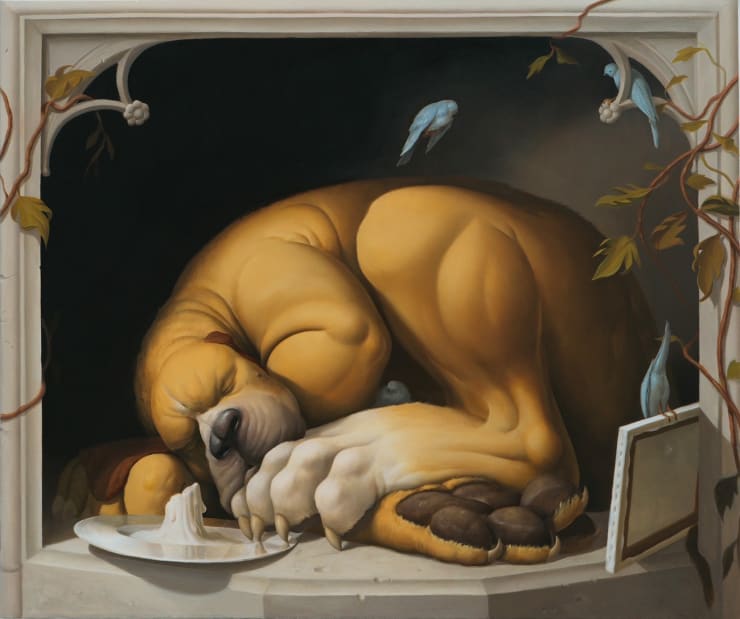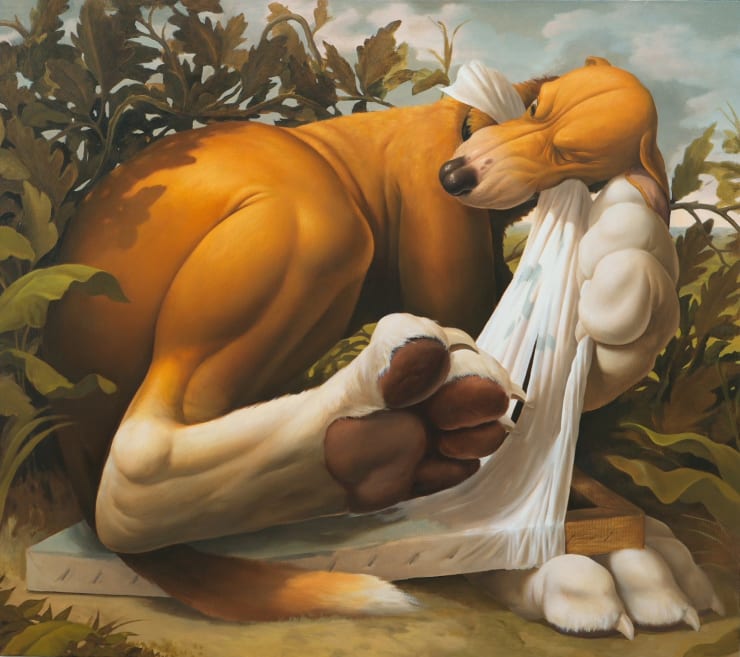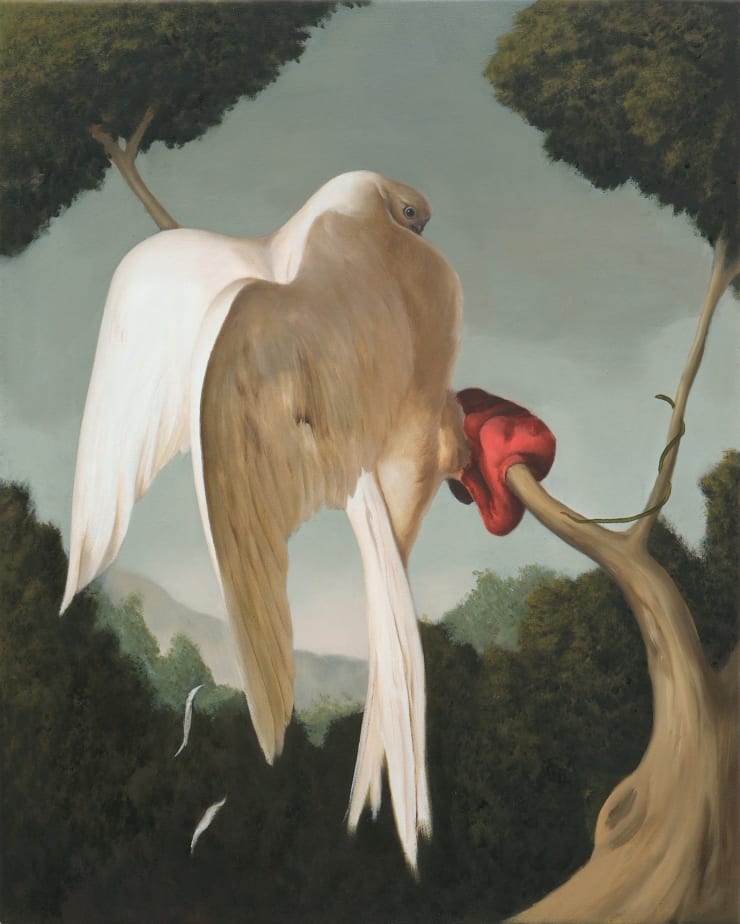Juan de Morenilla: Dog Bless You
Dog Bless You is the second solo exhibition of the artist Juan de Morenilla (Spain, 1992) at VETA by Fer Francés. The paintings, made specifically for the exhibition, draw from Flemish and Spanish baroque painting, enhancing these influences through contact with a personal universe reminiscent of comics or animated series and films, with which theartist has maintained a close relationship since his childhood.
Several of the paintings present natural sceneries in which aesthetic aspects are a thesaurus that may remind us of those developed by Frans Snyders or Paul de Vos and that are revealed as precisely that, sceneries. In this way, from the very material condition of painting, a generalized questioning of its representation is carried out, both of its illusionary character and of its possibility of unveiling.
The play on words that gives the exhibition its title alludes precisely to this question, where art and artifice are equally valued. The human impulse of faith, to fabricate fictions in which to take refuge or recreate oneself, can fall equally on the image (painting) as on its support (frame). God and Dog, Lord and Servant. The idea of salvation does not belong exclusively to a transcendental axis, but is located in the world: it is available in the practice of painting itself, where oversized, mythological dogs, along with other animals and objects, embody the History of Art. But, for the first time, we have access to its backstage: we see the Madonna in action, Santo Domingo's dog resting from its paper or vegetables that seem to have fallen from the unstable windowsill where Sánchez Cotán placed them. The delicate balance of the illusion is exposed and we see the real material of the cascade, the structures of the dioramas or even the characters themselves. The pictorial artifice, which, like all art, we often demand that it harbors something hidden, a reading beyond what is seen -again that need for faith-, suddenly contains, in itself, a pang of reality. Like a real toad in an imaginary garden.
The externalization of the springs of the mechanism, from within the pictorial fiction itself, far from undermining the contemplative experience, adds an absurdist dignity to the painting. We then knowingly enjoy its artificial workmanship, indeed, precisely because of its effortful honesty, we are able to value it more intensely. As in that poem, Theatre Impressions, where Wisława Szymborska vindicates the power of the spectacle at the exact moment when it reveals its trick, and then urges us to enjoy it, until the very end:
But the curtain's fall is the most uplifting part,
the things you see before it hits the floor:
here one hand quickly reaches for a flower,
there another hand picks up a fallen sword.
Only then, one last, unseen, hand
does its duty
and grabs me by the throat.
-
 Juan de MorenillaDómini canis, 2024Oil on canvas / Óleo sobre lienzo160 x 190 cm
Juan de MorenillaDómini canis, 2024Oil on canvas / Óleo sobre lienzo160 x 190 cm
63 x 74 3/4 in -
 Juan de MorenillaCob's dream, 2024Oil on canvas / Óleo sobre lienzo180 x 160 cm
Juan de MorenillaCob's dream, 2024Oil on canvas / Óleo sobre lienzo180 x 160 cm
70 7/8 x 63 in -
 Juan de MorenillaLélapé, 2024Óleo sobre lienzo160 x 180 cm
Juan de MorenillaLélapé, 2024Óleo sobre lienzo160 x 180 cm
63 x 70 7/8 inCourtesy of Veta Galeria SLCopyright The Artist -
 Juan de MorenillaNo hay banda, 2024Oil on canvas160 x 130 cm
Juan de MorenillaNo hay banda, 2024Oil on canvas160 x 130 cm
63 x 51 1/8 inCourtesy of Veta Galeria SLCopyright The Artist -
 Juan de MorenillaLa batata, 2024Oil on canvas160 x 180 cm
Juan de MorenillaLa batata, 2024Oil on canvas160 x 180 cm
63 x 70 7/8 inCourtesy of Veta Galeria SLCopyright The Artist -
 Juan de MorenillaClave de FA, 2024Oil on canvas54 x 61 cm
Juan de MorenillaClave de FA, 2024Oil on canvas54 x 61 cm
21 1/4 x 24 inCourtesy of Veta Galeria SLCopyright The Artist -
 Juan de MorenillaClave de DO, 2024Oil on canvas81 x 66 cm
Juan de MorenillaClave de DO, 2024Oil on canvas81 x 66 cm
31 7/8 x 26 inCourtesy of Veta Galeria SLCopyright The Artist -
 Juan de MorenillaDog bless you, 2024Oil on canvas195 x 146 cm
Juan de MorenillaDog bless you, 2024Oil on canvas195 x 146 cm
76 3/4 x 57 1/2 inCourtesy of Veta Galeria SLCopyright The Artist -
 Juan de MorenillaDídimo, 2024Oil on canvas160 x 130 cm
Juan de MorenillaDídimo, 2024Oil on canvas160 x 130 cm
63 x 51 1/8 inCourtesy of Veta Galeria SLCopyright The Artist -
 Juan de MorenillaTipo psíquico, 2024Oil on canvas100 x 82 cm
Juan de MorenillaTipo psíquico, 2024Oil on canvas100 x 82 cm
39 3/8 x 32 1/4 inCourtesy of Veta Galeria SLCopyright The Artist












